

D-myo-Inositol-1,5-diphosphate, sodium salt の分子構造
D-myo-Inositol-1,5-diphosphate, sodium salt
別名:
Ins(1,5)-P2 (sodium salt); D- myo- inositol- 1, 5- di(hydrogen phosphate), disodium salt
アプリケーション:
D-myo-Inositol-1,5-diphosphate, sodium saltは、イノシトールリン酸(InsP)分子ファミリーのメンバーです
純度:
>98%
分子量:
384.1
分子式:
C6H12O12P2•2Na
試験・研究用以外には使用しないでください。 臨床及び体外診断には使用できません。
* Refer to Certificate of Analysis for lot specific data.
クイックリンク
注文情報
説明
技術サポート情報
安全情報
SDSと分析証明書
D-ミオ-イノシトール-1,5-二リン酸ナトリウム塩は、イノシトール環の1位と5位に結合したリン酸基を持ち、重要な細胞内シグナル伝達経路を制御する多様なイノシトールリン酸化合物群の一部である。ホスホイノシチド代謝との関連性が認められており、細胞内シグナル伝達を研究するための貴重なツールとなっている。この化合物は、リン酸化状態がイノシトールリン酸の挙動や機能にどのように影響するかを理解するのに役立つ。研究者たちはこの化合物を利用して、リン酸化イノシチドシグナル伝達カスケードにおける特定のリン酸化パターンの役割を解明している。特に、キナーゼとホスファターゼがどのようにホスファチジルイノシトールの存在を制御しているかを明らかにする上で不可欠である、ホスファチジルイノシトールサイクルへの貢献が研究されている。この研究は、細胞増殖、分化、ストレス応答に関するシグナル伝達の基礎となるメカニズムの説明に役立つ。さらに、D-ミオ-イノシトール-1,5-二リン酸は、カルシウム動員、膜動態、タンパク質間相互作用に対するイノシトールリン酸の影響を調べる研究にも用いられている。明確なリン酸化パターンを提供することで、受容体相互作用の特異性と様々な細胞コンパートメントに対する下流の影響を明らかにするのに役立つ。したがって、代謝、アポトーシス、免疫応答といった多様な細胞活動におけるイノシトールリン酸の役割についての理解を深めることができる。
D-myo-Inositol-1,5-diphosphate, sodium salt 参考文献
- イノシトールリン酸生化学。 | Majerus, PW. 1992. Annu Rev Biochem. 61: 225-50. PMID: 1323235
- イノシトール-1,4,5-三リン酸による膵尖形細胞の非ミトコンドリア性細胞内貯蔵庫からのCa2+の放出。 | Streb, H., et al. Nature. 306: 67-9. PMID: 6605482
- イノシトール三リン酸とカルシウムシグナル。 | Berridge, MJ. 1993. Nature. 361: 315-25. PMID: 8381210
- ホルモン, 神経伝達物質, およびGタンパク質に連結する他のアゴニストによるホスホイノシチドホスホリパーゼの制御。 | Exton, JH. 1996. Annu Rev Pharmacol Toxicol. 36: 481-509. PMID: 8725399
- イノシトール1,4,5-三リン酸受容体の構造と機能。 | Yoshida, Y. and Imai, S. 1997. Jpn J Pharmacol. 74: 125-37. PMID: 9243320
注文情報
| 製品名 | カタログ # | 単位 | 価格 | 数量 | お気に入り | |
D-myo-Inositol-1,5-diphosphate, sodium salt, 100 µg | sc-223928 | 100 µg | $98.00 | |||
D-myo-Inositol-1,5-diphosphate, sodium salt, 500 µg | sc-223928A | 500 µg | $444.00 |
